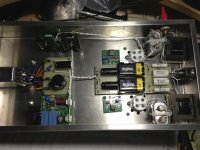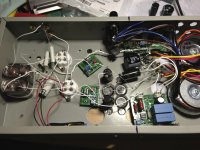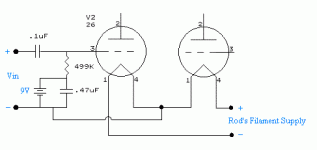Don't change the power transformer until you have connected the regulator up correctly! The circuit looks fine as it is. You can tune the 440uF capacitor in size, but you won't get anywhere until you connect the whole supply to the combination of 26 + cathode resistor.
Thank you Andy! I will leave it as is then.
Abe
I finally finished my flea-powered 26 headphone amplifier. I just had to wait 6 weeks for the Edcor OPTs. Unfortunately those nice looking tube shields I made induce hum  . It's a good thing they can be unscrewed easily. It's the exact opposite of my experience with the 26 linestage I built over 10 years ago using Ronan regulators where I had to use shields to reduce hum. Without the shields, it's as quiet as death. I can't hear anything with my efficient Sony 7506s...at least until I play music. With 1Vrms in I get about 3mW out which is louder than my comfort level. The sound character is what you'd expect from a 26
. It's a good thing they can be unscrewed easily. It's the exact opposite of my experience with the 26 linestage I built over 10 years ago using Ronan regulators where I had to use shields to reduce hum. Without the shields, it's as quiet as death. I can't hear anything with my efficient Sony 7506s...at least until I play music. With 1Vrms in I get about 3mW out which is louder than my comfort level. The sound character is what you'd expect from a 26  . Pictured below are the test circuit and the final build. Would you believe the test circuit was also quiet as death?
. Pictured below are the test circuit and the final build. Would you believe the test circuit was also quiet as death?
Attachments
Could you tell us what pcb's you used? I noticed the K&K CCS board and Rod Coleman's regs. But the other one I'm curious about. Is that the K&K version of Salas's shunt reg?I finally finished my flea-powered 26 headphone amplifier.
Last edited:
Could you tell us what pcb's you used? I noticed the K&K CCS board and Rod Coleman's regs. But the other one I'm curious about. Is that the K&K version of Salas's shunt reg?
That's tomchr's (Neurochrome audio) version of a Maida regulator on the lower left. I enjoyed doing the surface mount assembly work...a little.
Thanks Thomas!
Edit: The tube shields work after all. I had just forgotten to tie my circuit ground to chassis with a resistor.
I finally finished my flea-powered 26 headphone amplifier. I just had to wait 6 weeks for the Edcor OPTs. Unfortunately those nice looking tube shields I made induce hum. It's a good thing they can be unscrewed easily. It's the exact opposite of my experience with the 26 linestage I built over 10 years ago using Ronan regulators where I had to use shields to reduce hum. Without the shields, it's as quiet as death. I can't hear anything with my efficient Sony 7506s...at least until I play music. With 1Vrms in I get about 3mW out which is louder than my comfort level. The sound character is what you'd expect from a 26
. Pictured below are the test circuit and the final build. Would you believe the test circuit was also quiet as death?
Very Nice, congratulations!
I finally finished my flea-powered 26 headphone amplifier. I just had to wait 6 weeks for the Edcor OPTs. Unfortunately those nice looking tube shields I made induce hum. It's a good thing they can be unscrewed easily. It's the exact opposite of my experience with the 26 linestage I built over 10 years ago using Ronan regulators where I had to use shields to reduce hum. Without the shields, it's as quiet as death. I can't hear anything with my efficient Sony 7506s...at least until I play music. With 1Vrms in I get about 3mW out which is louder than my comfort level. The sound character is what you'd expect from a 26
. Pictured below are the test circuit and the final build. Would you believe the test circuit was also quiet as death?
Very nice and clean construction! So, all is in one box and is quiet?!?
Very nice and clean construction! So, all is in one box and is quiet?!?
Yep, two tubes, one box. I think all these wonderful modules that are available (Rod's filament boards, Tomchr's regulator, K&K CCS boards, Salas, Tentlabs, etc.) have made it so much easier to get great performance without resorting to ponderous construction projects.
How did you wire Rod's boards to the 26? It looks like they are in series. But how do you bias them in that case?Yep, two tubes, one box. I think all these wonderful modules that are available (Rod's filament boards, Tomchr's regulator, K&K CCS boards, Salas, Tentlabs, etc.) have made it so much easier to get great performance without resorting to ponderous construction projects.
Last edited:
O, that's interesting. I would expect that a 1.5V alkaline cell would suffice to balance them approximately, since the shift in bias equals 1x Vf (filament voltage). In case of #26 this is 1.5V..
Of course, this assumes that the 26s draw the same current at equal bias, which may not be so.
Of course, this assumes that the 26s draw the same current at equal bias, which may not be so.
O, that's interesting. I would expect that a 1.5V alkaline cell would suffice to balance them approximately, since the shift in bias equals 1x Vf (filament voltage). In case of #26 this is 1.5V..
Of course, this assumes that the 26s draw the same current at equal bias, which may not be so.
There's no imbalance, I just didn't draw the input circuitry for the other channel's tube. Each tube has its own battery. I lucked out with heater resistance matching since each tube develops 1.52-1.54V across its own filament. While there is a 1.5V difference in voltage referenced from the grid to each end of the cathode, isn't the effective bias voltage the lower potential in this case?
A simple question;
Has someone tried LIFEPO4 battery for filament supply?
It looks like no one...Need to try...
I'm sure many of us have at one time or another tried batteries for filaments. You'll probably find that most have given up on batteries. I frankly didn't find that they sounded any better than a choke input supply with one of Rod's regulators. So the added grief of charging batteries etc was simply not worth it. And even if batteries were favoured for a DHT, this would be more appropriate for the lower current ones rather than the 26 which is rather hungry. Even worse for filament bias.
A simple question;
Has someone tried LIFEPO4 battery for filament supply?
I don't believe there are any good reasons to try any battery for a filament supply!
In the case of LiFePO4 cells, the terminal voltage varies from 3,5V or more, down to 2,0V. The terminal voltage varies with temperature, too.
Meanwhile, for the 26 filament, the specification for the filament is 1,5V. To get the proper lifetime of the 26, the long-term voltage should be toleranced: +0, -4%. In other words the supply to the filament should keep within 1,44V to 1,50V - for most of the time, anyway. Running above the rated 1,5V is crazy - the lifetime will degrade very fast.
so to use a LiFePO4 cell on a 26 will require a regulator, unless you don't care about the life of the DHT.
Also, there is no guarantee that the cell will be quiet - other chemistries like lead-acid are in fact notoriously noisy.
Next, you will need a circuit to detect that the battery is low on voltage, and switch off the B+.
You can see from many reports in this thread that you can achieve complete silence with a 26, by using good B+ filtering or regulation, and my filament regulator kits.
With the complexity of charging, and low-voltage detection, the battery solution will cost much more, and still be a nuisance when you forget to recharge etc. And the sound is certainly not improved, nor is the noise!
I don't believe there are any good reasons to try any battery for a filament supply!
In the case of LiFePO4 cells, the terminal voltage varies from 3,5V or more, down to 2,0V. The terminal voltage varies with temperature, too.
Meanwhile, for the 26 filament, the specification for the filament is 1,5V. To get the proper lifetime of the 26, the long-term voltage should be toleranced: +0, -4%. In other words the supply to the filament should keep within 1,44V to 1,50V - for most of the time, anyway. Running above the rated 1,5V is crazy - the lifetime will degrade very fast.
so to use a LiFePO4 cell on a 26 will require a regulator, unless you don't care about the life of the DHT.
Also, there is no guarantee that the cell will be quiet - other chemistries like lead-acid are in fact notoriously noisy.
Next, you will need a circuit to detect that the battery is low on voltage, and switch off the B+.
You can see from many reports in this thread that you can achieve complete silence with a 26, by using good B+ filtering or regulation, and my filament regulator kits.
With the complexity of charging, and low-voltage detection, the battery solution will cost much more, and still be a nuisance when you forget to recharge etc. And the sound is certainly not improved, nor is the noise!
Thank you Rod,
I see...
I had your filament supply in 71A tube amp and was very happy,
now I didint yet decided what to use for 26.
I want to do it in separate case, so if I would use your filament supply
then the transformers would be in the other case, so the CLC filtering of DC...
How long can the wires be from one case to another (from DC basic filtering to filament boards)???
- Home
- Amplifiers
- Tubes / Valves
- #26 pre amp


